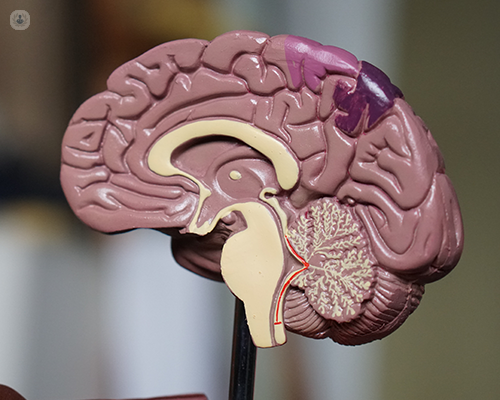Pineal gland
Dr Sobia Arshad - Endocrinology, diabetes & metabolism
Created on: 11-13-2012
Updated on: 03-30-2023
Edited by: Carlota Pano
What is the pineal gland?
The pineal gland is a small endocrine gland found deep in the middle of the brain, specifically in the epithalamus. It is shaped like a small pinecone, about 5-8 millimetres in size and weighs about 150 milligrams. It typically grows until you are around two years old, although its weight increases until adolescence.
Interestingly, the pineal gland is outside the blood-brain barrier - a semi-permeable barrier that separates the circulating blood and extracellular fluid in the central nervous system. It also allows the passage of water, gases and molecules.

What are the main functions of the pineal gland?
The main hormone produced by the pineal gland is melatonin, often referred to as the ‘sleep hormone’, which regulates the body’s circadian rhythm (internal or biological clock).
Melatonin is a hormone found in humans, animals, fungi, plants and bacteria. It participates in different cellular, neuroendocrine and neurophysiological processes, such as controlling the daily sleep cycle of the body. Deficits of this substance can result in insomnia and depression.
The pineal gland works by responding to the variations of light that occur around us, releasing different amounts of melatonin depending on how light or dark it is. For example, when it is dark, the pineal gland releases greater amounts of melatonin, making us feel sleepy.
The pineal gland is also linked to a range of other key body functions:
- Strengthens the immune system
- Promotes healthy bones
- Regulates endocrine functions
- Regulates the circadian rhythm and sleep cycles
- Regulates seasonal rhythms, stress, physical performance and mood
- Influences sex hormones
- Plays a role in spatial navigation
Complications with the pineal gland
The main problem with the pineal gland is that it may start accumulating calcium deposits (a process called calcification). Over the years, phosphate crystals form and the pineal gland hardens, which impairs its ability to produce melatonin. This results in a lower production of melatonin. This is why as you age, your sleep cycle tends to alter and you experience more sleep disturbances. It is still unclear why calcification of the pineal gland exactly occurs.
In addition, calcification of the pineal gland is also related to Alzheimer's disease, some types of migraines and changes to fertility, menstrual cycle or ovulation.
The pineal gland is also closely linked with the hypothalamus – a small region of the brain that releases hormones and regulates body temperature. If problems occur with this part of the brain, it can cause pineal gland dysfunction. The most common symptom of pineal gland dysfunction is an alteration in circadian rhythms, meaning that you may sleep too little, too much, be restless in the night or fall asleep at unusual times.
Although rare, pineal gland tumours can also develop. These are serious disorders that can grow until they press against other parts of the brain. They can also block the flow of the cerebrospinal fluid, which is the fluid that surrounds and protects the brain, increasing the pressure inside the brain. This is dangerous and requires immediate medical attention.
Pineal gland cysts
Pineal gland cysts, which are fluid-filled spaces within the pineal gland, may also develop. These are common, affecting nearly five per cent of adults – the majority being women who are 20 to 30 years old.
Cysts that form in the pineal gland are benign (non-cancerous) and almost always, asymptomatic (meaning that they don’t cause any symptoms). When symptoms do appear, these can include headaches, problems with vision, hydrocephalus (excess fluid in the brain) and problems with the eyes’ movement. For this reason, no treatment is generally needed for most pineal gland cysts.
In most cases, pineal gland cysts are detected when an MRI scan is performed for another reason, such as a brain injury, a dizzy spell or a migraine.
Are there any treatments for pineal gland problems?
To avoid calcification of the pineal gland, it is important to control your vitamin D intake, as too much induces calcification. Also, reduce your intake of calcium supplements as well as fluoride (a natural mineral present in some water supplies) by adding filters to minimise the intake of fluoridated public water and buy fluoride-free toothpaste.
As for pineal gland tumours, surgical intervention may be required, but the gland is very difficult to extract in this area of the brain. Radiotherapy and/or chemotherapy may be offered, but the exact treatment will depend on the type, size and location of the tumour and the patient’s health considerations and wishes.
Which specialist treats pineal gland problems?
A specialist who treats pineal gland complications is an endocrinologist.
Are the pineal gland and the pituitary gland the same?
The pituitary gland is a pea-sized gland located at the base of the base, behind the bridge of the nose, which regulates vital body functions. It is often referred to as the ‘master gland’ because it secretes and controls hormones that act on the thyroid gland, the adrenal gland, the ovaries and testes, to in turn produce other hormones. Through the secretion of all these hormones, the pituitary gland monitors growth, metabolism, reproduction, blood pressure and other key body processes.
The pineal gland, on the other hand, is a pinecone-shaped gland located in the middle of the brain and the body’s principal site for the production of melatonin.
